Content
- The process and timing of tattoo healing
- Stages of proper tattoo healing
- How to properly care for a tattoo?
- What if the tattoo is healing too slowly?
- Signs of inflammation and suppuration of a tattoo
- Pus
- Fever and lethargy
- Pain
- Redness and warmth
- Blistering or rash
- Hard bumps in the tattoo area
- What infections can I get from a tattoo?
- How to heal an inflamed tattoo
- Drugs
- Folk remedies
- What should not be done during the healing period of a tattoo?
- What does improper tattoo care lead to in the long term?
- Inflamed Tattoo Treatment Videos
Tattoo is an original way to emphasize image or commitment to something. But at the same time, a fresh drawing is an open wound into which an infection can penetrate. If a person is worried about redness, pain, fluid from the injured area, or suppuration, measures should be taken to eliminate complications immediately.
The process and timing of tattoo healing
A tattoo is considered completely healed if it has not festered, and peeling, dryness and shine disappear in the treated area. On average, this process takes 3-5 weeks. After this time, you can stop using special skin care products.
The healing time of the tattoo varies depending on the place of application:
- in places with a large amount of subcutaneous fat (belly, buttocks) - 7-10 days;
- in places with a small amount of subcutaneous fat (ribs, ankle) - 12-15 days;
- if the tattoo was applied in 2 stages or color correction was performed - 1-2 months.

There are cases when the tattoo does not heal for more than 2 months. If this happens, it is necessary to wipe the drawing with a cotton pad soaked in Chlorhexidine 1-2 times a day every day. After this, a healing ointment should be applied (for example, Traumeel-S, Bepanten, Etoniy). During this period, the use of cosmetic or baby creams is prohibited.
Stages of proper tattoo healing
The healing time of a tattoo is individual for each person and depends on the characteristics of the body and the place of treatment.
The following stages can be distinguished:
- The first 1-2 days a swelling appears at the site of treatment. Also, at this time, a liquid may be released - colorless or have a shade of the injected pigment. This condition lasts up to 5 days.
- After 5-10 days, the swelling gradually subsides and the skin becomes drier. During this time, the tattoo may itch. A person needs to try not to influence the place where the drawing is applied.
- After 10-15 days, the discomfort disappears, and peeling and dryness disappear from the skin.
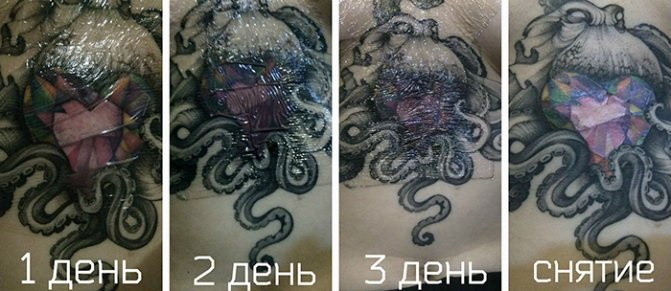 To understand if the tattoo is completely healed, you need to run your hand over it. If there are no unpleasant sensations, there are no roughness - this means that the skin has recovered. At first, the drawing may fade, but over time, the brightness will return.
To understand if the tattoo is completely healed, you need to run your hand over it. If there are no unpleasant sensations, there are no roughness - this means that the skin has recovered. At first, the drawing may fade, but over time, the brightness will return.
How to properly care for a tattoo?
To avoid inflammation, and the tattoo does not fester, it is important after the procedure to properly care for the place where the drawing is applied.
Tattoo care is divided into 3 stages: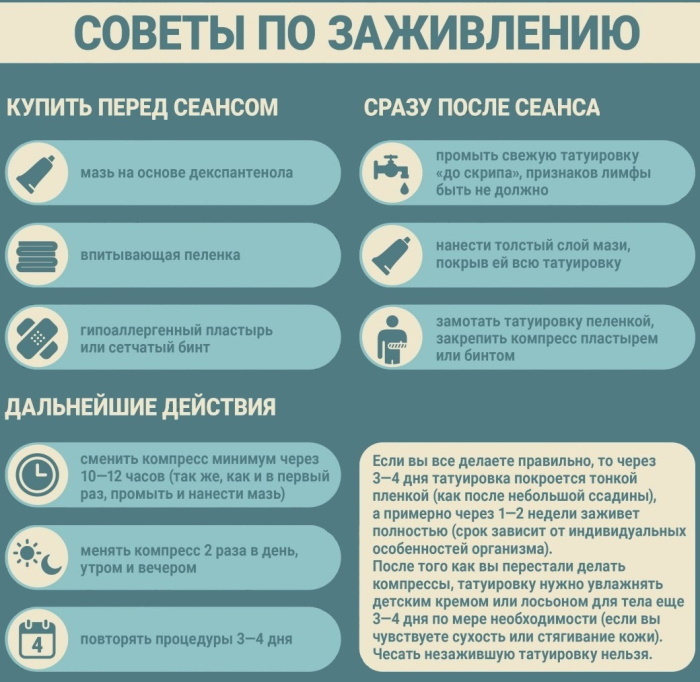
| Stage and its duration | Human sensations | Care procedures |
| Stage 1 lasts 1-2 days | Through small cracks, an ichor is released from the skin, which is a sign of the beginning of the recovery process. It can be dyed to match the ink. Also, the person sees the swelling of the treated area. | In the early days, care is especially important, since the skin is damaged and needs it - the quality of the pattern depends on it. The film with the healing ointment applied by the master must not be removed until you return home. Then you need to rinse the skin with warm water and let it dry naturally. Do not use a towel and washcloth. |
| Stage 2 lasts 2-10 days | A person feels swelling of the skin, tightness, dryness appears - this indicates dehydration, which is a normal reaction to a foreign object (ink). | At this time, you need to apply a healing cream so that rejection does not occur and the ink takes root on the skin. Contact with clothing slows down the healing process, so you should try to eliminate friction and leave the skin open - after that the tattoo will be covered with a crust. |
| Stage 3 lasts from 10 days to 2 months, depending on the condition of the skin and the size of the pattern | Itching, peeling appears - this means that the ink has taken root inside the tissues, and new skin has begun to form above them. | During this period, it is forbidden to comb the area of the drawing, it is also forbidden to remove the crust. You can lightly pat the itchy area, apply an antiseptic and special creams. You also need to temporarily limit visits to the gym so that the skin does not sweat. It is not advisable to be in the sun until the tattoo has healed. |
What if the tattoo is healing too slowly?
A slow recovery of the skin after drawing a pattern can be observed in such cases:
- feature of the organism. If a person has chronic skin diseases or metabolic disorders, the wound will heal slowly;
- proper care. If the recommendations for caring for the injured area are violated, the healing process is inhibited;
- unskilled drawing. If the tattoo is done incorrectly, the skin can be unnecessarily traumatized, which increases the recovery time.
In order for the tattoo to heal faster, it is important to follow these recommendations:
- do not cover the treated area of the body with a cloth - the skin must breathe, and the material prevents the flow of air to the wound;
- limit skin contact with foreign objects and animals - friction can cause irritation;
- using an antiseptic (such as chlorhexidine) - this will help limit the growth of bacteria in the damaged area;
- apply anti-inflammatory ointment 1-2 times a day, which will help relieve swelling and redness of the skin.
Signs of inflammation and suppuration of a tattoo
The tattoo site is prone to infection as it is an open wound through which germs can enter. If a person experiences discomfort in the area of the drawing, this is the first symptom of incipient inflammation. It is at this time that it is time to start worrying about treatment.
Pus
The tattoo has festered and turned red - this means that the area where the drawing is applied is infected.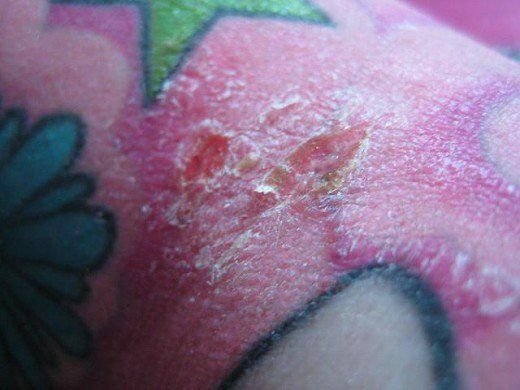
In this place, liquid may be released:
- transparent;
- golden color;
- ichor;
- thick mucus.
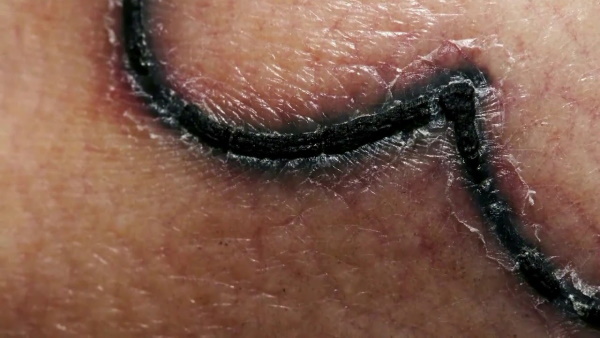
Also, there are frequent cases of accumulation of pus (from white to green). Sometimes the discharge from a tattoo has an unpleasant odor - this is an unmistakable sign of severe inflammation that requires treatment. In these cases, you should immediately contact a dermatologist.
Fever and lethargy
If fever and lethargy cannot be associated with another disease, for example ARVI, then this is a sign of infection of the body and the beginning of the struggle of immunity with harmful microorganisms.
Pain
The norm is the presence of pain within 1-2 days after tattooing. Further, the symptoms should gradually disappear. If the pain increases or its area increases, this is a sign of infection.
Redness and warmth
Swelling and slight reddening of the tattoo is normal 1-2 days after the tattoo is applied. If a similar condition is observed for 3-5 days or increases in size, going beyond the treatment area, you should consult a dermatologist. Also, the reason for going to the doctor is the presence of red stripes that diverge from the pattern in different directions - this may be an early symptom of blood poisoning.
A person may feel warmth or record a significant increase in body temperature in the area of the tattoo. This condition can be considered normal within 1-2 days, but the temperature should decrease by 3-4 days. A similar condition is the reaction of local immunity to skin damage in order to destroy harmful microorganisms. If the temperature rises or the hot zone expands, this indicates inflammation.
Blistering or rash
Blisters are a sign of an upper skin infection when lymphatic fluid accumulates underneath. This condition can be observed on a part of the tattoo. Bubbles sometimes burst, and a wet ulcer forms in their place.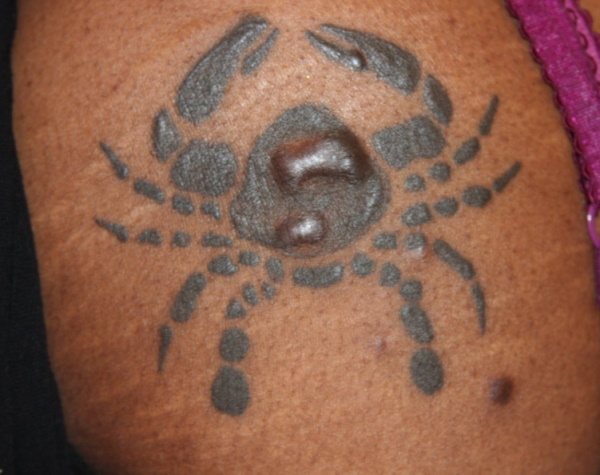
Rash - Small pimples that can itch and hurt. This is often an allergic reaction to the dye or treatments. Such a symptom should be reported to the master. Sometimes, especially in the summer, people smear the tattoo site with cosmetic cream. Such care clogs the pores and prevents the skin from breathing, which leads to the appearance of acne.
Hard bumps in the tattoo area
For some people, relief appears in the first week after tattooing - this is normal and this condition will decrease within 1-2 months.
Reasons for relief:
- with the inexperience of the master, when the work is done deeply, this cannot be avoided;
- the disorder of the typewriter and the inexperience of the master who did not notice this;
- individual feature of the skin in the area of drawing;
- a feature of the picture, which requires a deep study of the contours;
- relief is a feature of white paint, since it is poorly driven into the skin.
Also, relief may appear on an already healed area - this is an individual sign of a change in blood pressure or an increase in physical activity.
Hard bumps can occur if you are allergic to dye, especially if the drawing was painted in red, or become a sign of inflammation of the inner layers of the skin. In any case, you need to consult a dermatologist and exclude suppuration.
What infections can I get from a tattoo?
Since a tattoo is an open wound, various microorganisms can penetrate through it.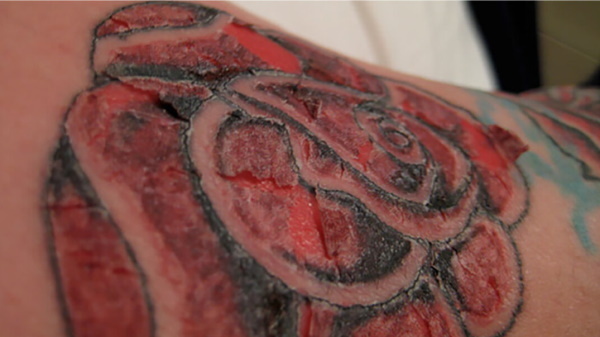
Among the common diseases, one can single out those that are indicated in the table:
| The disease and its causes | Symptoms | What you can do yourself |
| A fungal infection is a lack of hygiene, since most often a fungal infection occurs in the feet and ankles. |
|
Use antifungal agents, change socks on time, wear clean shoes, and avoid walking barefoot in the gym or public shower. |
| Microbacterial infection - occurs due to the unclean water used for diluting the ink, which is used by the master. |
|
See a dermatologist. In this case, self-treatment is unacceptable. |
| E. coli is most often caused by a tattoo in the groin, pubic area or buttocks due to possible contact of the instrument with feces. |
|
|
| A bacterial infection (Staphylococcus aureus) appears from non-sterile equipment in the cabin. |
|
Treatment under the supervision of a therapist is indicated. |
| Viral infections. If the sanitary requirements are not observed in the salon, then a person can become infected with HIV, hepatitis B or C, herpes, and viral warts may appear. |
|
|
| Allergic reaction to ink. Most often, the human body reacts to material with haptens in its composition - they are common in red, blue and green pigments. |
|
To reduce the risk of infection at the time of tattooing, a person should adhere to the following recommendations:
- check the wizard's license before performing the procedure;
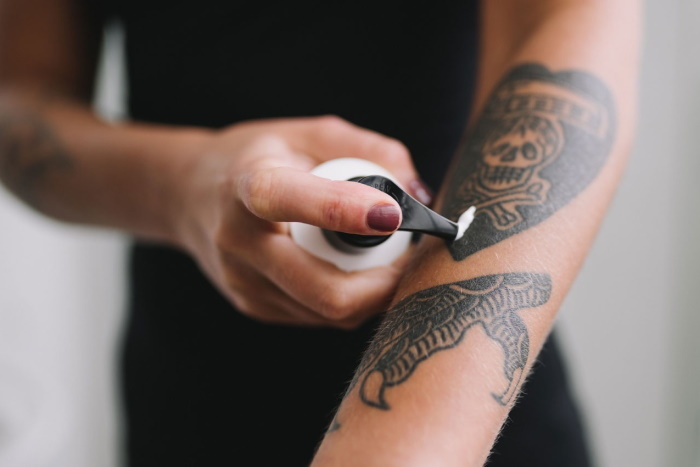
- ask about hygiene and monitor its observance during work (disposable materials and a needle, the presence of gloves);
- inquire about sterilization and handling of equipment and workplace;
- after completing the work, ask the master to provide written recommendations for skin care;
- in order not to get infected on the street immediately after applying a tattoo, the master must apply a bandage and give instructions on further actions;
- keep the tattoo clean during the entire healing period;
- do not remove the crust that appears in the picture.
How to heal an inflamed tattoo
If the tattoo is festering or flushed a lot - in any case, a qualified dermatologist should treat the inflammation. The doctor will conduct an examination, prescribe tests and determine the correct set of medicines to alleviate the person's condition. Independent attempts at therapy can have a negative effect on the body and aggravate the situation.
Drugs
To eliminate the symptoms of inflammation, the following medications are used:
- antihistamines designed to relieve allergy symptoms. Medication can help relieve swelling and itching. They must be taken with or after meals. An example of a remedy is Diphenhydramine;
- wound healing cream. The drug should contain regenerating components (for example, vitamin B5) and antibacterial compounds (for example, chlorhexidine). Dyes and fragrances in the composition will negatively affect the skin. The cream should be used 2 times a day. Among the proven means:
- Bepanten is an antiseptic cream that soothes the skin. Contains an antiseptic and has no contraindications;
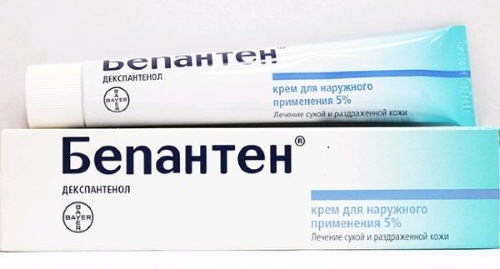
- Solcoseryl is a natural-based gel that accelerates skin regeneration;
- Doctor Pro is a professional cream for healing tattoos, which contains an antiseptic, vitamin F and natural ingredients - chamomile and tea tree oil;
- Miramistin is an aqueous solution with a bactericidal effect;
- Tattoo Goo Original (USA) - a lotion designed specifically for the healing of tattoos. It contains natural ingredients;
- Bacitracin is an antimicrobial ointment that can be prescribed after consulting a dermatologist;
- anti-inflammatory drugs (such as paracetamol) help relieve pain for the first 8-24 hours after the procedure;
- antibiotics will be prescribed by a doctor if the skin condition does not improve after 2 weeks. The dermatologist will prescribe tests and, if necessary, a biopsy, after which he will select the appropriate composition of medicines;
- topical steroid-based ointments can help relieve allergic reactions to the dye. Among the medicines that a dermatologist prescribes may be: Prednisolone, Advantan, Flutnar, Celistoderm.
Folk remedies
The tattoo has festered or signs of inflammation have appeared, in any case, folk remedies will help to alleviate the condition.
As an adjunctive therapy to drugs, steps can be taken:
- apply ice. Ice or something cold should be wrapped in a towel and applied to the inflamed area for 10 minutes. The procedure can be repeated 3 times a day;
- petroleum jelly or non-adhesive bandage. A thin layer of petroleum jelly and a bandage will help protect damaged skin from dirt, dust, and sun damage. The bandage should be changed daily. If it sticks to your skin, you can dampen the top of the fabric with warm water;
- aloe vera juice can be used to relieve inflammation. Apply the liquid to the tattoo and wait until it dries.
What should not be done during the healing period of a tattoo?
The tattoo has festered or discomfort does not go away - this means that the treated area is inflamed, the recommendations for caring for it have not been followed.
Until the tattoo has healed, you should adhere to the following restrictions:
- do not comb the drawing;
- do not visit the solarium and do not sunbathe in the sun;
- exclude the use of alcohol, as it raises blood pressure and can cause leaching of pigment from the skin;
- limit visits to the gym, otherwise sweat can provoke an inflammatory process and lead to irritation;
- limit mechanical impact on damaged skin, including rubbing with clothing;
- in the summer, apply sunscreen to the drawing, otherwise the tattoo will become faded.
What does improper tattoo care lead to in the long term?
Failure to follow the recommendations of the tattoo care master prolongs the healing period, and can also cause a number of negative consequences.
Common skin reactions are:
- the appearance of scars;
- blurring the outline of the picture;
- the occurrence of an allergic reaction, which can become chronic in the absence of timely treatment;
- the presence of scars that appear a year after the drawing has been applied;
- pigmentation of the skin;
- sensitivity to light;
- keratoacanthoma - a benign formation on the skin;
- enlarged lymph nodes.
As a rule, the tattoo ceases to cause discomfort after 1-2 weeks after application. If a person has inflammation, the wrong treatment was prescribed, or it was not carried out at all, then complications may appear. Most are treatable, but skin and blood infections can lead to life-threatening circumstances.
A beautiful and high-quality tattoo is the merit of not only the master, but also the result of a person's correct actions in everyday life. If the recommendations for care are not followed, the drawing may fester and fade, which will ruin its aesthetic beauty.
Inflamed Tattoo Treatment Videos
The tattoo got inflamed. What to do? How to avoid?



